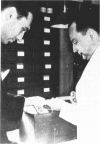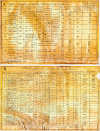Saul Hertz, MD, and the birth of radionuclide therapy
- PMID: 28451906
- PMCID: PMC5407393
- DOI: 10.1186/s40658-017-0182-7
Saul Hertz, MD, and the birth of radionuclide therapy
Abstract
The year, 2016, marked the 75th anniversary of Dr. Saul Hertz first using radioiodine to treat a patient with thyroid disease. In November of 1936, a luncheon was held of the faculty of Harvard Medical School where Karl Compton, PhD, president of the Massachusetts Institute of Technology was invited to give a presentation entitled "What Physics Can Do for Biology and Medicine." Saul Hertz who attended the luncheon spontaneously asked the very pertinent question that perhaps changed the course of treatment of thyroid disease, "Could iodine be made radioactive artificially?" We review the events leading up to the asking of this question, the preclinical investigations by Dr. Hertz and his colleague Arthur Roberts prior to the treatment of the first patient and what occurred in the years following this landmark event. This commentary seeks to set the record straight to the sequence of events leading to the first radioiodine therapy, so that those involved can be recognized with due credit.
Keywords: History; Radioiodine therapy; Saul Hertz.
Figures



References
-
- Joliot F, Curie I. Artificial production of a new kind of radio-element. Nature. 1934;133(3354):201–202. doi: 10.1038/133201a0. - DOI
-
- Means J, Holmes G. Further observations on the Roentgen-Ray treatment of toxic goiter. Tr A Am Phys. 1922;37:198.
-
- de Hevesy G. Nobel lecture: some applications of isotopic indicators. 1943. www.nobelprize.org/noble_prizes/chemistry/laureates/1943/. - PubMed
-
- Hertz S, Roberts A, Evans RD. Radioactive iodine as an indicator in the study of thyroid physiology. Exp Biol Med. 1938;38(4):510–513. doi: 10.3181/00379727-38-9915P. - DOI
Publication types
LinkOut - more resources
Full Text Sources
Other Literature Sources

